Comprehensive Book Analysis Report: Pride and Prejudice by Jane Austen
VerifiedAdded on 2021/04/17
|9
|2149
|62
Report
AI Summary
This report offers a comprehensive analysis of Jane Austen's *Pride and Prejudice*. It begins with a summary of the novel's plot, focusing on the Bennet family and the societal pressures of the Regency period. The analysis delves into special narrative features, such as the narrator's point of view and indirect discourse, which contribute to the story's depth. The report then examines the incorporation of key literary theories, including strategic manipulation, feminist literary criticism, and Marxist theory, demonstrating how these theories illuminate the characters' actions and the novel's underlying themes. Furthermore, the report discusses the novel's relevance to the culture of Singapore, highlighting parallels between the societal dynamics depicted in the book and the historical context of Singapore. The analysis concludes by emphasizing the enduring appeal of *Pride and Prejudice* and its continued relevance as a social commentary and a timeless love story.
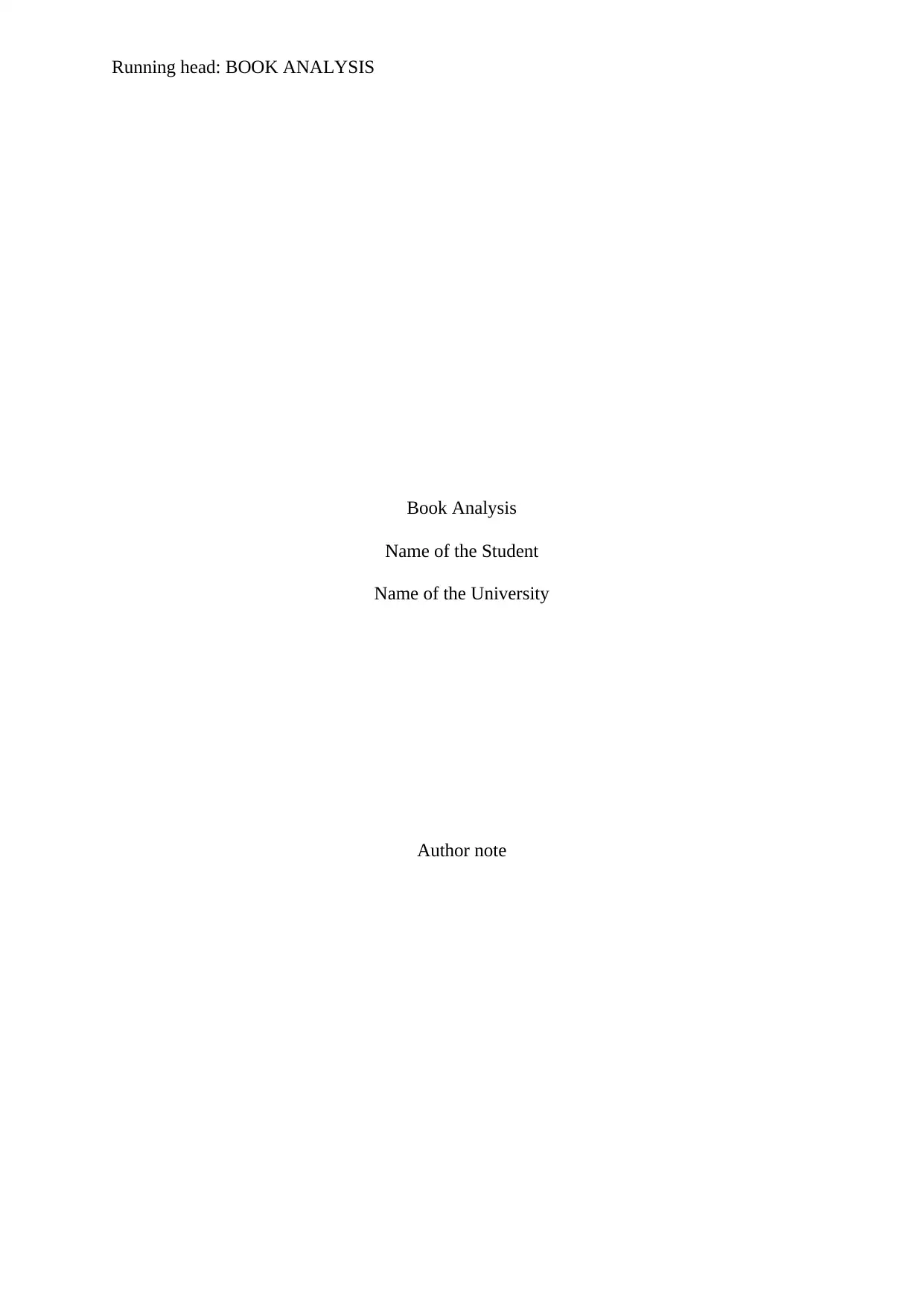
Running head: BOOK ANALYSIS
Book Analysis
Name of the Student
Name of the University
Author note
Book Analysis
Name of the Student
Name of the University
Author note
Paraphrase This Document
Need a fresh take? Get an instant paraphrase of this document with our AI Paraphraser
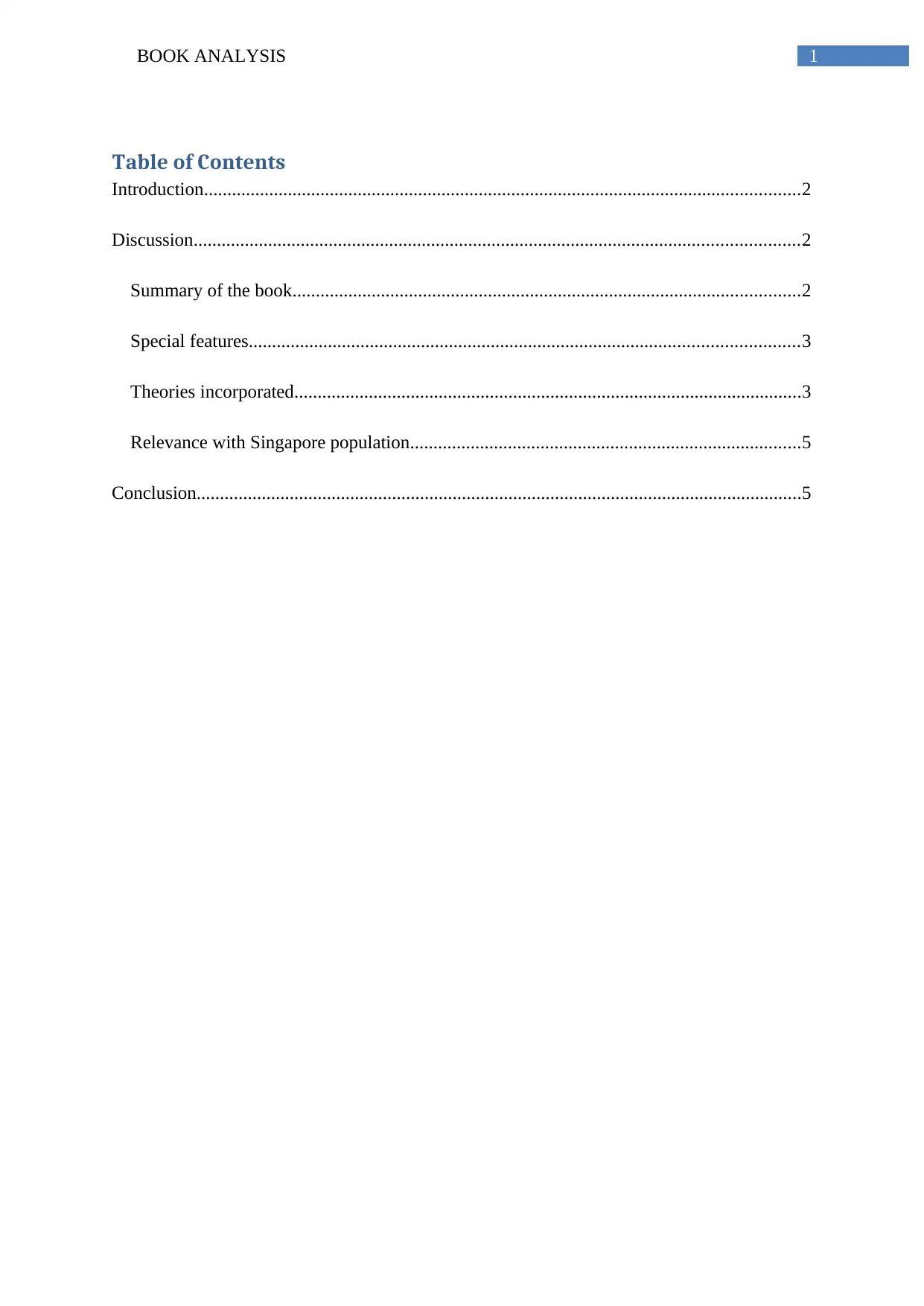
1BOOK ANALYSIS
Table of Contents
Introduction................................................................................................................................2
Discussion..................................................................................................................................2
Summary of the book.............................................................................................................2
Special features......................................................................................................................3
Theories incorporated.............................................................................................................3
Relevance with Singapore population....................................................................................5
Conclusion..................................................................................................................................5
Table of Contents
Introduction................................................................................................................................2
Discussion..................................................................................................................................2
Summary of the book.............................................................................................................2
Special features......................................................................................................................3
Theories incorporated.............................................................................................................3
Relevance with Singapore population....................................................................................5
Conclusion..................................................................................................................................5
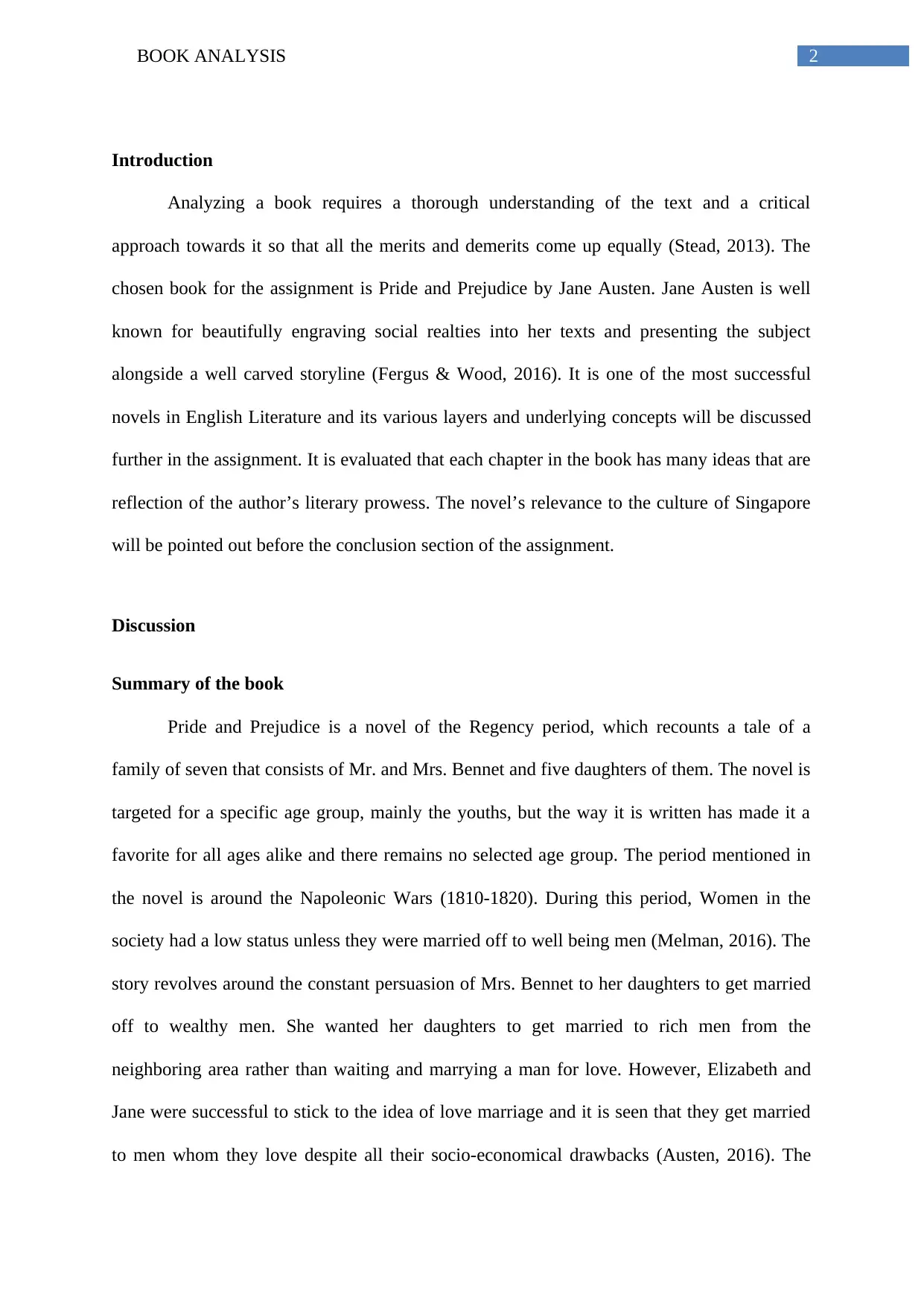
2BOOK ANALYSIS
Introduction
Analyzing a book requires a thorough understanding of the text and a critical
approach towards it so that all the merits and demerits come up equally (Stead, 2013). The
chosen book for the assignment is Pride and Prejudice by Jane Austen. Jane Austen is well
known for beautifully engraving social realties into her texts and presenting the subject
alongside a well carved storyline (Fergus & Wood, 2016). It is one of the most successful
novels in English Literature and its various layers and underlying concepts will be discussed
further in the assignment. It is evaluated that each chapter in the book has many ideas that are
reflection of the author’s literary prowess. The novel’s relevance to the culture of Singapore
will be pointed out before the conclusion section of the assignment.
Discussion
Summary of the book
Pride and Prejudice is a novel of the Regency period, which recounts a tale of a
family of seven that consists of Mr. and Mrs. Bennet and five daughters of them. The novel is
targeted for a specific age group, mainly the youths, but the way it is written has made it a
favorite for all ages alike and there remains no selected age group. The period mentioned in
the novel is around the Napoleonic Wars (1810-1820). During this period, Women in the
society had a low status unless they were married off to well being men (Melman, 2016). The
story revolves around the constant persuasion of Mrs. Bennet to her daughters to get married
off to wealthy men. She wanted her daughters to get married to rich men from the
neighboring area rather than waiting and marrying a man for love. However, Elizabeth and
Jane were successful to stick to the idea of love marriage and it is seen that they get married
to men whom they love despite all their socio-economical drawbacks (Austen, 2016). The
Introduction
Analyzing a book requires a thorough understanding of the text and a critical
approach towards it so that all the merits and demerits come up equally (Stead, 2013). The
chosen book for the assignment is Pride and Prejudice by Jane Austen. Jane Austen is well
known for beautifully engraving social realties into her texts and presenting the subject
alongside a well carved storyline (Fergus & Wood, 2016). It is one of the most successful
novels in English Literature and its various layers and underlying concepts will be discussed
further in the assignment. It is evaluated that each chapter in the book has many ideas that are
reflection of the author’s literary prowess. The novel’s relevance to the culture of Singapore
will be pointed out before the conclusion section of the assignment.
Discussion
Summary of the book
Pride and Prejudice is a novel of the Regency period, which recounts a tale of a
family of seven that consists of Mr. and Mrs. Bennet and five daughters of them. The novel is
targeted for a specific age group, mainly the youths, but the way it is written has made it a
favorite for all ages alike and there remains no selected age group. The period mentioned in
the novel is around the Napoleonic Wars (1810-1820). During this period, Women in the
society had a low status unless they were married off to well being men (Melman, 2016). The
story revolves around the constant persuasion of Mrs. Bennet to her daughters to get married
off to wealthy men. She wanted her daughters to get married to rich men from the
neighboring area rather than waiting and marrying a man for love. However, Elizabeth and
Jane were successful to stick to the idea of love marriage and it is seen that they get married
to men whom they love despite all their socio-economical drawbacks (Austen, 2016). The
⊘ This is a preview!⊘
Do you want full access?
Subscribe today to unlock all pages.

Trusted by 1+ million students worldwide
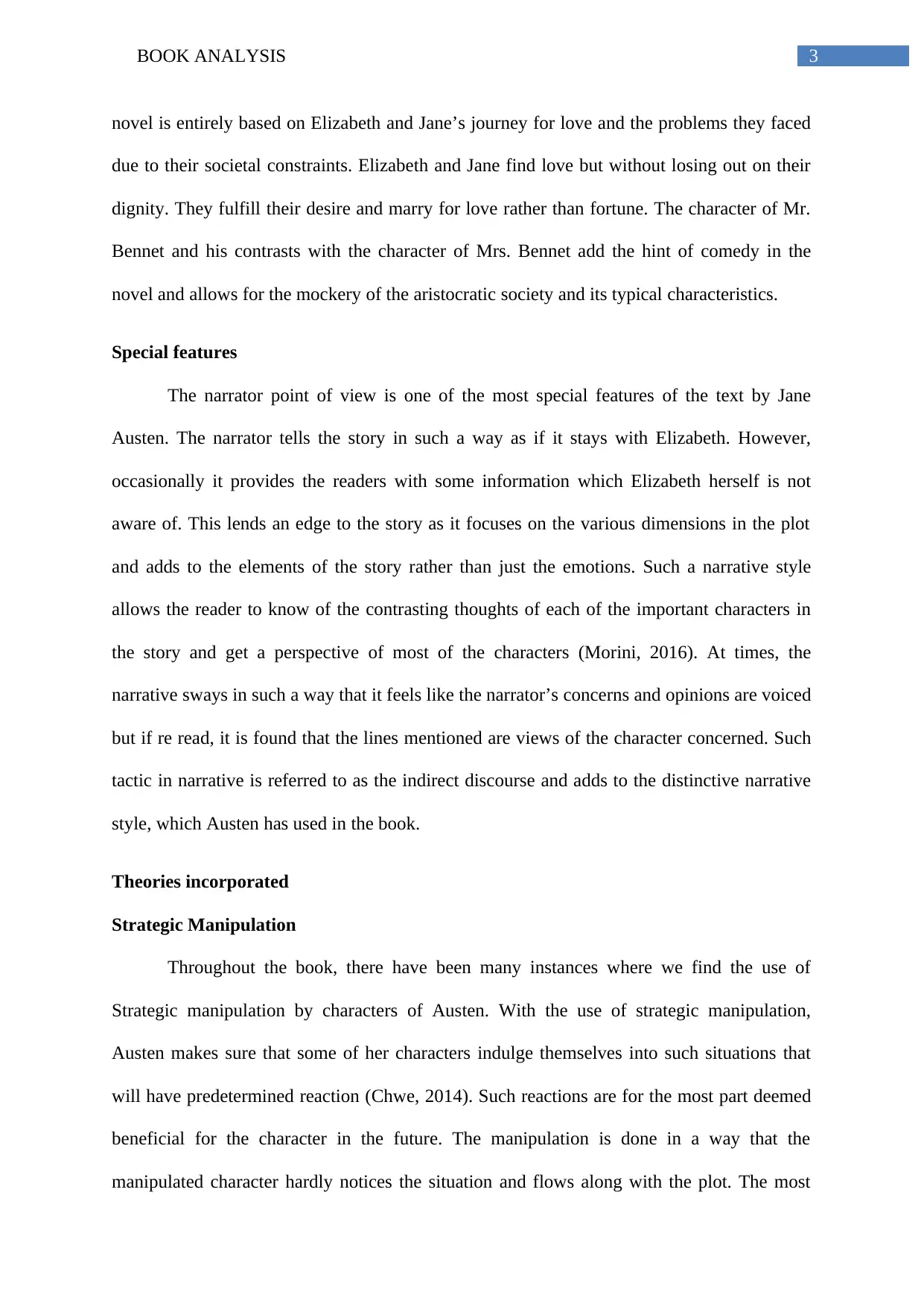
3BOOK ANALYSIS
novel is entirely based on Elizabeth and Jane’s journey for love and the problems they faced
due to their societal constraints. Elizabeth and Jane find love but without losing out on their
dignity. They fulfill their desire and marry for love rather than fortune. The character of Mr.
Bennet and his contrasts with the character of Mrs. Bennet add the hint of comedy in the
novel and allows for the mockery of the aristocratic society and its typical characteristics.
Special features
The narrator point of view is one of the most special features of the text by Jane
Austen. The narrator tells the story in such a way as if it stays with Elizabeth. However,
occasionally it provides the readers with some information which Elizabeth herself is not
aware of. This lends an edge to the story as it focuses on the various dimensions in the plot
and adds to the elements of the story rather than just the emotions. Such a narrative style
allows the reader to know of the contrasting thoughts of each of the important characters in
the story and get a perspective of most of the characters (Morini, 2016). At times, the
narrative sways in such a way that it feels like the narrator’s concerns and opinions are voiced
but if re read, it is found that the lines mentioned are views of the character concerned. Such
tactic in narrative is referred to as the indirect discourse and adds to the distinctive narrative
style, which Austen has used in the book.
Theories incorporated
Strategic Manipulation
Throughout the book, there have been many instances where we find the use of
Strategic manipulation by characters of Austen. With the use of strategic manipulation,
Austen makes sure that some of her characters indulge themselves into such situations that
will have predetermined reaction (Chwe, 2014). Such reactions are for the most part deemed
beneficial for the character in the future. The manipulation is done in a way that the
manipulated character hardly notices the situation and flows along with the plot. The most
novel is entirely based on Elizabeth and Jane’s journey for love and the problems they faced
due to their societal constraints. Elizabeth and Jane find love but without losing out on their
dignity. They fulfill their desire and marry for love rather than fortune. The character of Mr.
Bennet and his contrasts with the character of Mrs. Bennet add the hint of comedy in the
novel and allows for the mockery of the aristocratic society and its typical characteristics.
Special features
The narrator point of view is one of the most special features of the text by Jane
Austen. The narrator tells the story in such a way as if it stays with Elizabeth. However,
occasionally it provides the readers with some information which Elizabeth herself is not
aware of. This lends an edge to the story as it focuses on the various dimensions in the plot
and adds to the elements of the story rather than just the emotions. Such a narrative style
allows the reader to know of the contrasting thoughts of each of the important characters in
the story and get a perspective of most of the characters (Morini, 2016). At times, the
narrative sways in such a way that it feels like the narrator’s concerns and opinions are voiced
but if re read, it is found that the lines mentioned are views of the character concerned. Such
tactic in narrative is referred to as the indirect discourse and adds to the distinctive narrative
style, which Austen has used in the book.
Theories incorporated
Strategic Manipulation
Throughout the book, there have been many instances where we find the use of
Strategic manipulation by characters of Austen. With the use of strategic manipulation,
Austen makes sure that some of her characters indulge themselves into such situations that
will have predetermined reaction (Chwe, 2014). Such reactions are for the most part deemed
beneficial for the character in the future. The manipulation is done in a way that the
manipulated character hardly notices the situation and flows along with the plot. The most
Paraphrase This Document
Need a fresh take? Get an instant paraphrase of this document with our AI Paraphraser
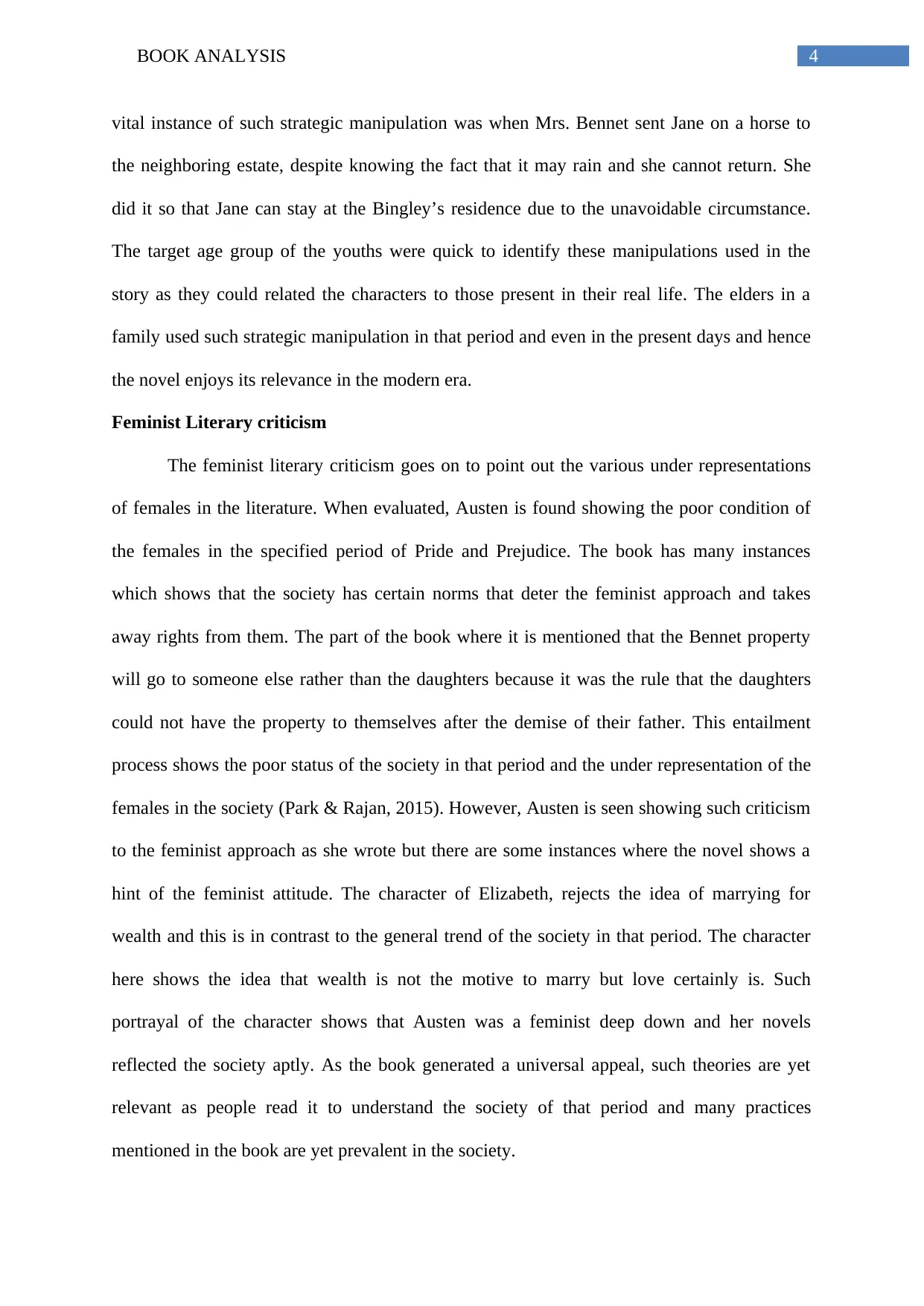
4BOOK ANALYSIS
vital instance of such strategic manipulation was when Mrs. Bennet sent Jane on a horse to
the neighboring estate, despite knowing the fact that it may rain and she cannot return. She
did it so that Jane can stay at the Bingley’s residence due to the unavoidable circumstance.
The target age group of the youths were quick to identify these manipulations used in the
story as they could related the characters to those present in their real life. The elders in a
family used such strategic manipulation in that period and even in the present days and hence
the novel enjoys its relevance in the modern era.
Feminist Literary criticism
The feminist literary criticism goes on to point out the various under representations
of females in the literature. When evaluated, Austen is found showing the poor condition of
the females in the specified period of Pride and Prejudice. The book has many instances
which shows that the society has certain norms that deter the feminist approach and takes
away rights from them. The part of the book where it is mentioned that the Bennet property
will go to someone else rather than the daughters because it was the rule that the daughters
could not have the property to themselves after the demise of their father. This entailment
process shows the poor status of the society in that period and the under representation of the
females in the society (Park & Rajan, 2015). However, Austen is seen showing such criticism
to the feminist approach as she wrote but there are some instances where the novel shows a
hint of the feminist attitude. The character of Elizabeth, rejects the idea of marrying for
wealth and this is in contrast to the general trend of the society in that period. The character
here shows the idea that wealth is not the motive to marry but love certainly is. Such
portrayal of the character shows that Austen was a feminist deep down and her novels
reflected the society aptly. As the book generated a universal appeal, such theories are yet
relevant as people read it to understand the society of that period and many practices
mentioned in the book are yet prevalent in the society.
vital instance of such strategic manipulation was when Mrs. Bennet sent Jane on a horse to
the neighboring estate, despite knowing the fact that it may rain and she cannot return. She
did it so that Jane can stay at the Bingley’s residence due to the unavoidable circumstance.
The target age group of the youths were quick to identify these manipulations used in the
story as they could related the characters to those present in their real life. The elders in a
family used such strategic manipulation in that period and even in the present days and hence
the novel enjoys its relevance in the modern era.
Feminist Literary criticism
The feminist literary criticism goes on to point out the various under representations
of females in the literature. When evaluated, Austen is found showing the poor condition of
the females in the specified period of Pride and Prejudice. The book has many instances
which shows that the society has certain norms that deter the feminist approach and takes
away rights from them. The part of the book where it is mentioned that the Bennet property
will go to someone else rather than the daughters because it was the rule that the daughters
could not have the property to themselves after the demise of their father. This entailment
process shows the poor status of the society in that period and the under representation of the
females in the society (Park & Rajan, 2015). However, Austen is seen showing such criticism
to the feminist approach as she wrote but there are some instances where the novel shows a
hint of the feminist attitude. The character of Elizabeth, rejects the idea of marrying for
wealth and this is in contrast to the general trend of the society in that period. The character
here shows the idea that wealth is not the motive to marry but love certainly is. Such
portrayal of the character shows that Austen was a feminist deep down and her novels
reflected the society aptly. As the book generated a universal appeal, such theories are yet
relevant as people read it to understand the society of that period and many practices
mentioned in the book are yet prevalent in the society.
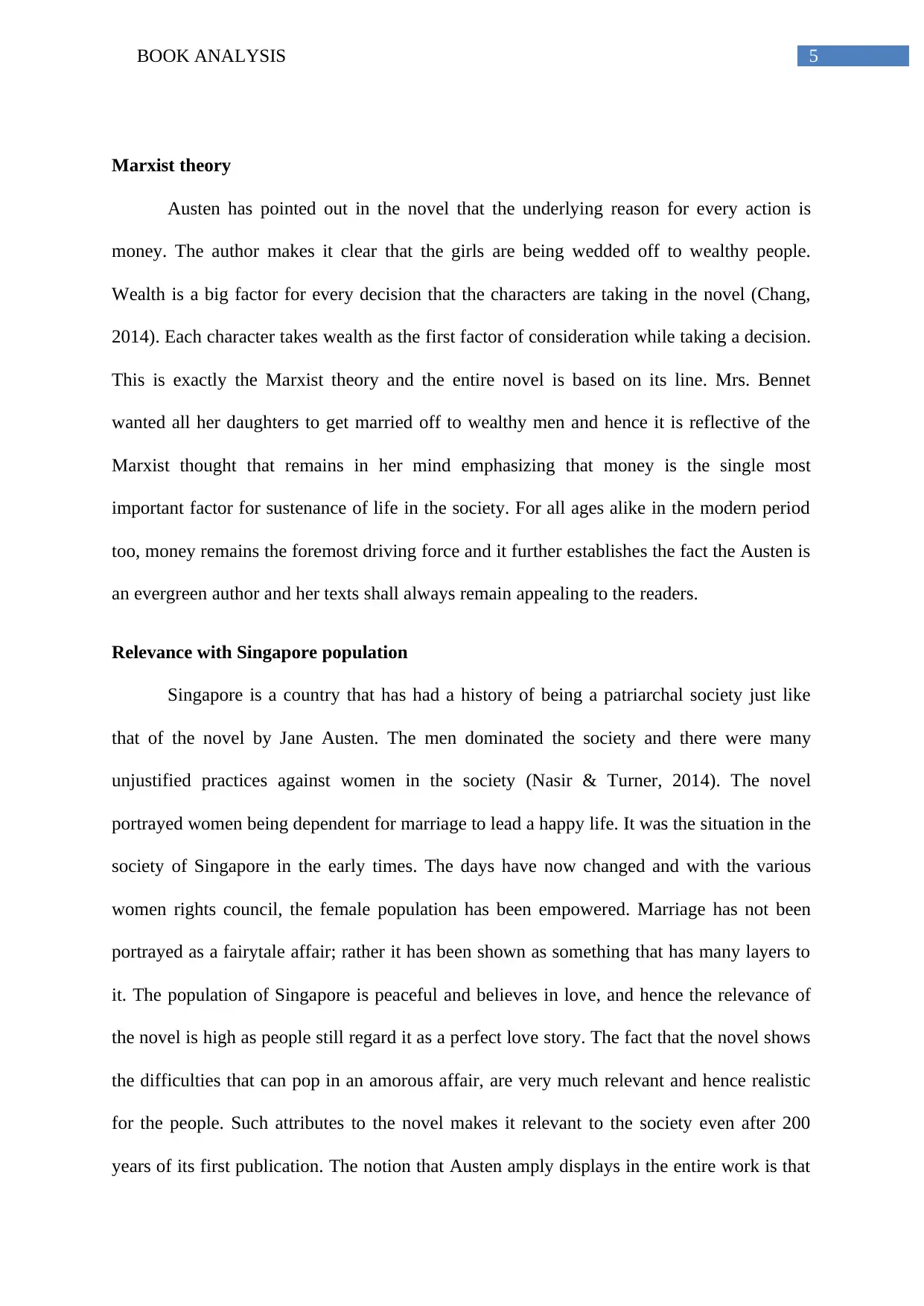
5BOOK ANALYSIS
Marxist theory
Austen has pointed out in the novel that the underlying reason for every action is
money. The author makes it clear that the girls are being wedded off to wealthy people.
Wealth is a big factor for every decision that the characters are taking in the novel (Chang,
2014). Each character takes wealth as the first factor of consideration while taking a decision.
This is exactly the Marxist theory and the entire novel is based on its line. Mrs. Bennet
wanted all her daughters to get married off to wealthy men and hence it is reflective of the
Marxist thought that remains in her mind emphasizing that money is the single most
important factor for sustenance of life in the society. For all ages alike in the modern period
too, money remains the foremost driving force and it further establishes the fact the Austen is
an evergreen author and her texts shall always remain appealing to the readers.
Relevance with Singapore population
Singapore is a country that has had a history of being a patriarchal society just like
that of the novel by Jane Austen. The men dominated the society and there were many
unjustified practices against women in the society (Nasir & Turner, 2014). The novel
portrayed women being dependent for marriage to lead a happy life. It was the situation in the
society of Singapore in the early times. The days have now changed and with the various
women rights council, the female population has been empowered. Marriage has not been
portrayed as a fairytale affair; rather it has been shown as something that has many layers to
it. The population of Singapore is peaceful and believes in love, and hence the relevance of
the novel is high as people still regard it as a perfect love story. The fact that the novel shows
the difficulties that can pop in an amorous affair, are very much relevant and hence realistic
for the people. Such attributes to the novel makes it relevant to the society even after 200
years of its first publication. The notion that Austen amply displays in the entire work is that
Marxist theory
Austen has pointed out in the novel that the underlying reason for every action is
money. The author makes it clear that the girls are being wedded off to wealthy people.
Wealth is a big factor for every decision that the characters are taking in the novel (Chang,
2014). Each character takes wealth as the first factor of consideration while taking a decision.
This is exactly the Marxist theory and the entire novel is based on its line. Mrs. Bennet
wanted all her daughters to get married off to wealthy men and hence it is reflective of the
Marxist thought that remains in her mind emphasizing that money is the single most
important factor for sustenance of life in the society. For all ages alike in the modern period
too, money remains the foremost driving force and it further establishes the fact the Austen is
an evergreen author and her texts shall always remain appealing to the readers.
Relevance with Singapore population
Singapore is a country that has had a history of being a patriarchal society just like
that of the novel by Jane Austen. The men dominated the society and there were many
unjustified practices against women in the society (Nasir & Turner, 2014). The novel
portrayed women being dependent for marriage to lead a happy life. It was the situation in the
society of Singapore in the early times. The days have now changed and with the various
women rights council, the female population has been empowered. Marriage has not been
portrayed as a fairytale affair; rather it has been shown as something that has many layers to
it. The population of Singapore is peaceful and believes in love, and hence the relevance of
the novel is high as people still regard it as a perfect love story. The fact that the novel shows
the difficulties that can pop in an amorous affair, are very much relevant and hence realistic
for the people. Such attributes to the novel makes it relevant to the society even after 200
years of its first publication. The notion that Austen amply displays in the entire work is that
⊘ This is a preview!⊘
Do you want full access?
Subscribe today to unlock all pages.

Trusted by 1+ million students worldwide
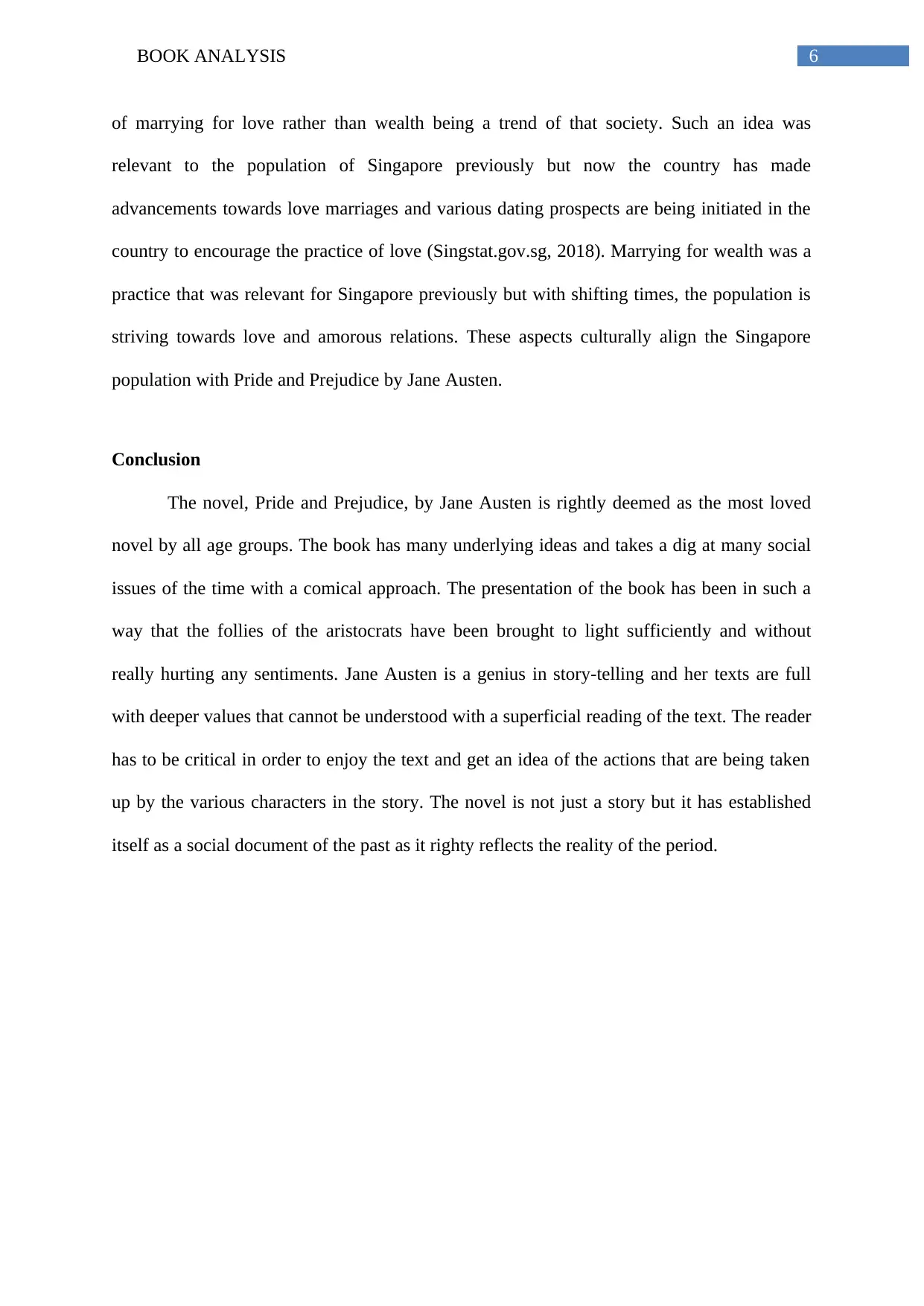
6BOOK ANALYSIS
of marrying for love rather than wealth being a trend of that society. Such an idea was
relevant to the population of Singapore previously but now the country has made
advancements towards love marriages and various dating prospects are being initiated in the
country to encourage the practice of love (Singstat.gov.sg, 2018). Marrying for wealth was a
practice that was relevant for Singapore previously but with shifting times, the population is
striving towards love and amorous relations. These aspects culturally align the Singapore
population with Pride and Prejudice by Jane Austen.
Conclusion
The novel, Pride and Prejudice, by Jane Austen is rightly deemed as the most loved
novel by all age groups. The book has many underlying ideas and takes a dig at many social
issues of the time with a comical approach. The presentation of the book has been in such a
way that the follies of the aristocrats have been brought to light sufficiently and without
really hurting any sentiments. Jane Austen is a genius in story-telling and her texts are full
with deeper values that cannot be understood with a superficial reading of the text. The reader
has to be critical in order to enjoy the text and get an idea of the actions that are being taken
up by the various characters in the story. The novel is not just a story but it has established
itself as a social document of the past as it righty reflects the reality of the period.
of marrying for love rather than wealth being a trend of that society. Such an idea was
relevant to the population of Singapore previously but now the country has made
advancements towards love marriages and various dating prospects are being initiated in the
country to encourage the practice of love (Singstat.gov.sg, 2018). Marrying for wealth was a
practice that was relevant for Singapore previously but with shifting times, the population is
striving towards love and amorous relations. These aspects culturally align the Singapore
population with Pride and Prejudice by Jane Austen.
Conclusion
The novel, Pride and Prejudice, by Jane Austen is rightly deemed as the most loved
novel by all age groups. The book has many underlying ideas and takes a dig at many social
issues of the time with a comical approach. The presentation of the book has been in such a
way that the follies of the aristocrats have been brought to light sufficiently and without
really hurting any sentiments. Jane Austen is a genius in story-telling and her texts are full
with deeper values that cannot be understood with a superficial reading of the text. The reader
has to be critical in order to enjoy the text and get an idea of the actions that are being taken
up by the various characters in the story. The novel is not just a story but it has established
itself as a social document of the past as it righty reflects the reality of the period.
Paraphrase This Document
Need a fresh take? Get an instant paraphrase of this document with our AI Paraphraser
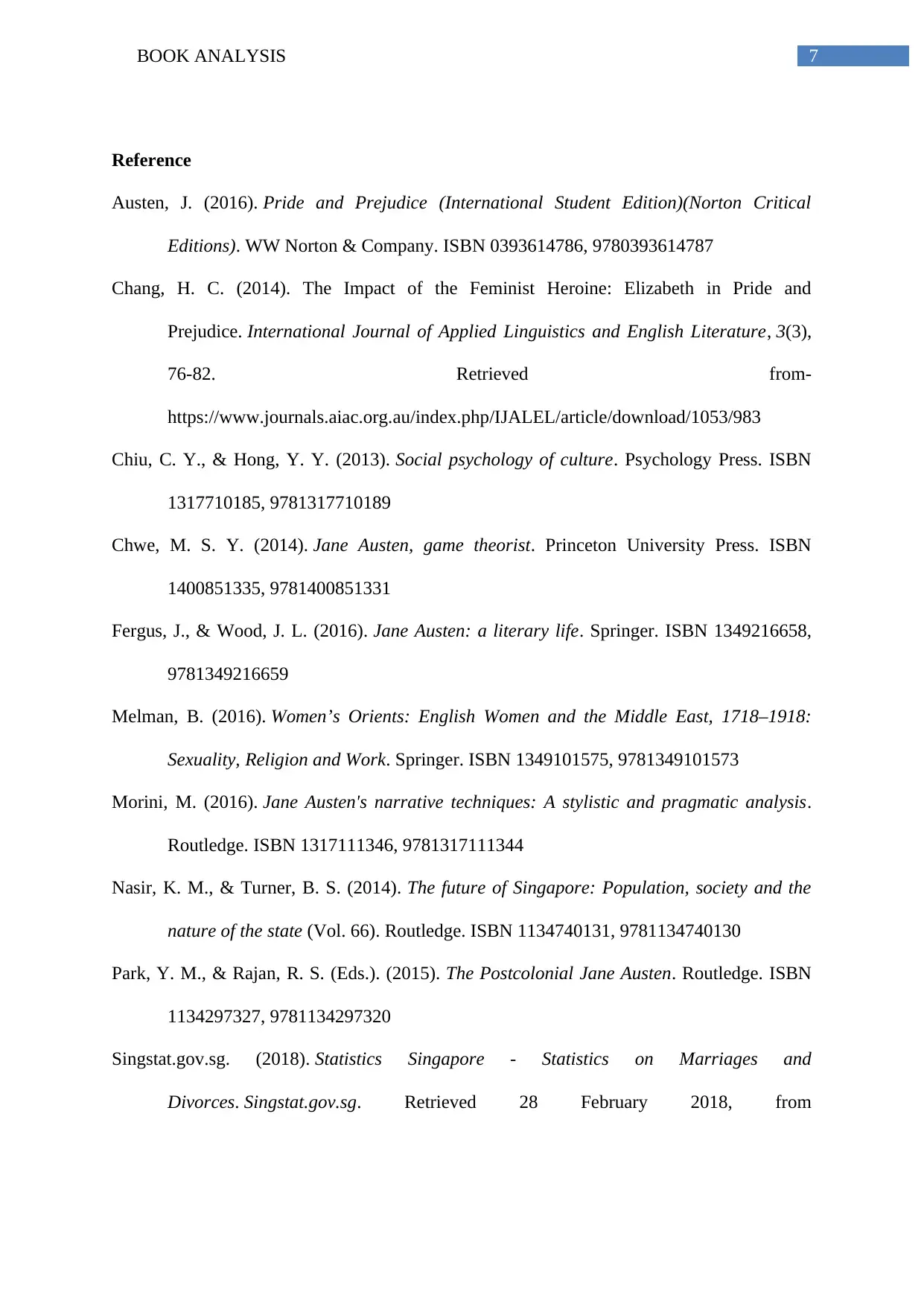
7BOOK ANALYSIS
Reference
Austen, J. (2016). Pride and Prejudice (International Student Edition)(Norton Critical
Editions). WW Norton & Company. ISBN 0393614786, 9780393614787
Chang, H. C. (2014). The Impact of the Feminist Heroine: Elizabeth in Pride and
Prejudice. International Journal of Applied Linguistics and English Literature, 3(3),
76-82. Retrieved from-
https://www.journals.aiac.org.au/index.php/IJALEL/article/download/1053/983
Chiu, C. Y., & Hong, Y. Y. (2013). Social psychology of culture. Psychology Press. ISBN
1317710185, 9781317710189
Chwe, M. S. Y. (2014). Jane Austen, game theorist. Princeton University Press. ISBN
1400851335, 9781400851331
Fergus, J., & Wood, J. L. (2016). Jane Austen: a literary life. Springer. ISBN 1349216658,
9781349216659
Melman, B. (2016). Women’s Orients: English Women and the Middle East, 1718–1918:
Sexuality, Religion and Work. Springer. ISBN 1349101575, 9781349101573
Morini, M. (2016). Jane Austen's narrative techniques: A stylistic and pragmatic analysis.
Routledge. ISBN 1317111346, 9781317111344
Nasir, K. M., & Turner, B. S. (2014). The future of Singapore: Population, society and the
nature of the state (Vol. 66). Routledge. ISBN 1134740131, 9781134740130
Park, Y. M., & Rajan, R. S. (Eds.). (2015). The Postcolonial Jane Austen. Routledge. ISBN
1134297327, 9781134297320
Singstat.gov.sg. (2018). Statistics Singapore - Statistics on Marriages and
Divorces. Singstat.gov.sg. Retrieved 28 February 2018, from
Reference
Austen, J. (2016). Pride and Prejudice (International Student Edition)(Norton Critical
Editions). WW Norton & Company. ISBN 0393614786, 9780393614787
Chang, H. C. (2014). The Impact of the Feminist Heroine: Elizabeth in Pride and
Prejudice. International Journal of Applied Linguistics and English Literature, 3(3),
76-82. Retrieved from-
https://www.journals.aiac.org.au/index.php/IJALEL/article/download/1053/983
Chiu, C. Y., & Hong, Y. Y. (2013). Social psychology of culture. Psychology Press. ISBN
1317710185, 9781317710189
Chwe, M. S. Y. (2014). Jane Austen, game theorist. Princeton University Press. ISBN
1400851335, 9781400851331
Fergus, J., & Wood, J. L. (2016). Jane Austen: a literary life. Springer. ISBN 1349216658,
9781349216659
Melman, B. (2016). Women’s Orients: English Women and the Middle East, 1718–1918:
Sexuality, Religion and Work. Springer. ISBN 1349101575, 9781349101573
Morini, M. (2016). Jane Austen's narrative techniques: A stylistic and pragmatic analysis.
Routledge. ISBN 1317111346, 9781317111344
Nasir, K. M., & Turner, B. S. (2014). The future of Singapore: Population, society and the
nature of the state (Vol. 66). Routledge. ISBN 1134740131, 9781134740130
Park, Y. M., & Rajan, R. S. (Eds.). (2015). The Postcolonial Jane Austen. Routledge. ISBN
1134297327, 9781134297320
Singstat.gov.sg. (2018). Statistics Singapore - Statistics on Marriages and
Divorces. Singstat.gov.sg. Retrieved 28 February 2018, from
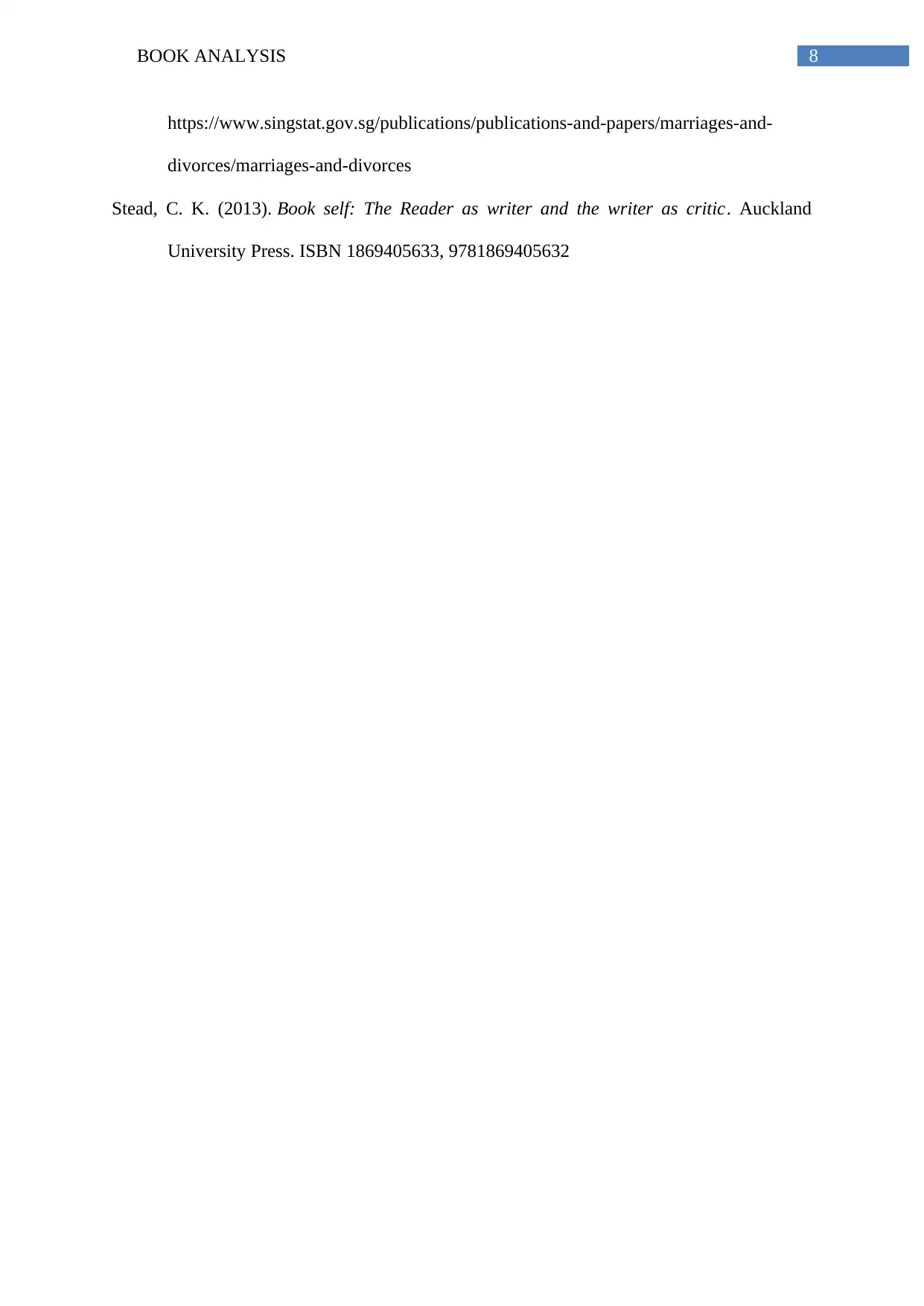
8BOOK ANALYSIS
https://www.singstat.gov.sg/publications/publications-and-papers/marriages-and-
divorces/marriages-and-divorces
Stead, C. K. (2013). Book self: The Reader as writer and the writer as critic. Auckland
University Press. ISBN 1869405633, 9781869405632
https://www.singstat.gov.sg/publications/publications-and-papers/marriages-and-
divorces/marriages-and-divorces
Stead, C. K. (2013). Book self: The Reader as writer and the writer as critic. Auckland
University Press. ISBN 1869405633, 9781869405632
⊘ This is a preview!⊘
Do you want full access?
Subscribe today to unlock all pages.

Trusted by 1+ million students worldwide
1 out of 9
Related Documents
Your All-in-One AI-Powered Toolkit for Academic Success.
+13062052269
info@desklib.com
Available 24*7 on WhatsApp / Email
![[object Object]](/_next/static/media/star-bottom.7253800d.svg)
Unlock your academic potential
Copyright © 2020–2025 A2Z Services. All Rights Reserved. Developed and managed by ZUCOL.





